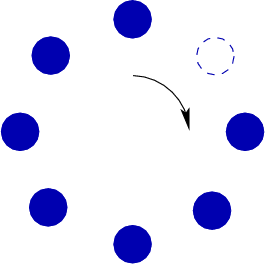
Next: Frame rates Up: 6.2 Perception of Motion Previous: Distinguishing object motion from Contents Index
 |
Nearly everyone on Earth has seen a motion picture, whether through a TV, smartphone, or movie screen. The motions we see are an illusion because a sequence of still pictures is being flashed onto the screen. This phenomenon is called stroboscopic apparent motion; it was discovered and refined across the 19th century. The zoetrope, shown in Figure 6.15 was developed around 1834. It consists of a rotating drum with slits that allow each frame to be visible for an instant while the drum rotates. In Section 1.3, Figure 1.24 showed the Horse in Motion film from 1878.
 |
Why does this illusion of motion work? An early theory, which has largely been refuted in recent years, is called persistence of vision. The theory states that images persist in the vision system during the intervals in between frames, thereby causing them to be perceived as continuous.
One piece of evidence against this theory is that images persist in the visual cortex for around ![]() ms, which implies that the
ms, which implies that the ![]() FPS (Frames Per Second) is the slowest speed that stroboscopic apparent motion would work; however, it is also perceived down to
FPS (Frames Per Second) is the slowest speed that stroboscopic apparent motion would work; however, it is also perceived down to ![]() FPS [312]. Another piece of evidence against the persistence of vision is the existence of stroboscopic apparent motions that cannot be accounted for by it. The phi phenomenon and beta movement are examples of motion perceived in a sequence of blinking lights, rather than flashing frames (see Figure 6.16). The most likely reason that stroboscopic apparent motion works is that it triggers the neural motion detection circuitry illustrated in Figure 6.12 [206,214].
FPS [312]. Another piece of evidence against the persistence of vision is the existence of stroboscopic apparent motions that cannot be accounted for by it. The phi phenomenon and beta movement are examples of motion perceived in a sequence of blinking lights, rather than flashing frames (see Figure 6.16). The most likely reason that stroboscopic apparent motion works is that it triggers the neural motion detection circuitry illustrated in Figure 6.12 [206,214].